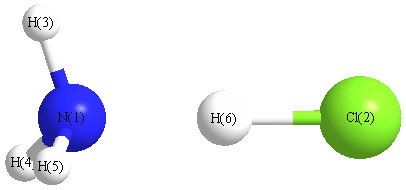Vibrational Frequencies calculated at B3LYP/CEP-31G*
| Mode Number |
Symmetry |
Frequency
(cm-1) |
Scaled Frequency
(cm-1) |
IR Intensities
(km mol-1) |
Raman Act
(Å4/u) |
Dep P |
Dep U |
|---|
| 1 |
A1 |
3465 |
3346 |
5.20 |
|
|
|
| 2 |
A1 |
1865 |
1801 |
2579.36 |
|
|
|
| 3 |
A1 |
1189 |
1149 |
86.74 |
|
|
|
| 4 |
A1 |
230 |
222 |
55.95 |
|
|
|
| 5 |
E |
3602 |
3478 |
13.02 |
|
|
|
| 5 |
E |
3602 |
3478 |
13.00 |
|
|
|
| 6 |
E |
1685 |
1627 |
26.48 |
|
|
|
| 6 |
E |
1685 |
1627 |
26.47 |
|
|
|
| 7 |
E |
968 |
934 |
80.59 |
|
|
|
| 7 |
E |
968 |
934 |
80.59 |
|
|
|
| 8 |
E |
293 |
283 |
20.06 |
|
|
|
| 8 |
E |
293 |
283 |
20.06 |
|
|
|
Unscaled Zero Point Vibrational Energy (zpe) 9922.7 cm
-1
Scaled (by 0.9657) Zero Point Vibrational Energy (zpe) 9582.3 cm
-1
See section
III.C.1 List or set vibrational scaling factors
to change the scale factors used here.
See section
III.C.2
Calculate a vibrational scaling factor for a given set of molecules
to determine the least squares best scaling factor.
Charges, Dipole, Quadrupole and Polarizability
Charges from optimized geometry at B3LYP/CEP-31G*
Charges (e)
| Number |
Element |
Mulliken |
CHELPG |
AIM |
ESP |
| 1 |
N |
-0.815 |
|
|
|
| 2 |
Cl |
-0.389 |
|
|
|
| 3 |
H |
0.312 |
|
|
|
| 4 |
H |
0.312 |
|
|
|
| 5 |
H |
0.312 |
|
|
|
| 6 |
H |
0.269 |
|
|
|
Electric dipole moments
Electric dipole components in Debye
(What's a Debye? See section
VII.A.3)
| |
x |
y |
z |
Total |
| |
0.000 |
0.000 |
-5.673 |
5.673 |
| CHELPG |
|
|
|
|
| AIM |
|
|
|
|
| ESP |
|
|
|
|
Electric Quadrupole moment
Quadrupole components in D Å
| Primitive |
|---|
| | x | y | z |
|---|
| x |
-19.477 |
0.000 |
0.000 |
| y |
0.000 |
-19.477 |
0.000 |
| z |
0.000 |
0.000 |
-14.069 |
|
| Traceless |
|---|
| | x | y | z |
|---|
| x |
-2.704 |
0.000 |
0.000 |
| y |
0.000 |
-2.704 |
0.000 |
| z |
0.000 |
0.000 |
5.408 |
|
| Polar |
|---|
| 3z2-r2 | 10.815 |
|---|
| x2-y2 | 0.000 |
|---|
| xy | 0.000 |
|---|
| xz | 0.000 |
|---|
| yz | 0.000 |
|---|
|
Polarizabilities
Components of the polarizability tensor.
Units are
Å
3 (Angstrom cubed)
Change units.
| |
x |
y |
z |
| x |
2.096 |
0.000 |
0.000 |
| y |
0.000 |
2.096 |
0.000 |
| z |
0.000 |
0.000 |
4.887 |
<r2> (average value of r
2) Å
2
| <r2> |
55.125 |
| (<r2>)1/2 |
7.425 |
